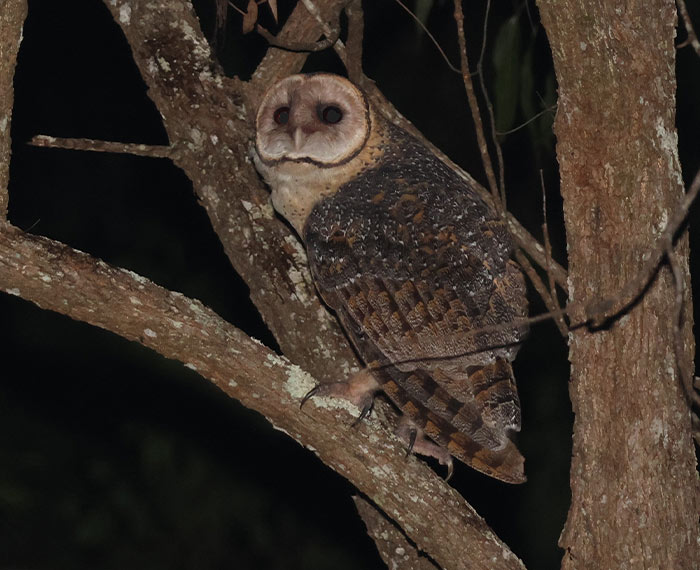Wildlife surveys show green shoots of recovery from devastating storms

This Australian masked owl was a rare sighting at Tamborine Mountain. Photo Greg Tasney
As Scenic Rim residents continue to repair and rebuild following the devastating Christmas-New Year storms, native animals are re-establishing their homes as green shoots of recovery appear in bushland areas.
Just weeks after the storms, a survey over three nights of a Council natural area at Tamborine aimed to assess the damage to habitat and its impacts on koalas and greater gliders to assist Scenic Rim Regional Council's efforts in protecting these endangered species.
Although the eucalypt forest on Tamborine Mountain Road was damaged during the storms, which felled some medium-sized gum trees and large branches, the survey showed it continues to provide refuge for koalas, brushtail possums, kangaroos, wallabies and numerous species of frog.
Environmental consultant Greg Tasney said the reserve had numerous species of gum tree, such as blue gum and tallowwood, providing food for koalas, and contributes to a corridor to Tamborine National Park for koalas moving overland.
"A single koala, a healthy adult with no signs of illness, was seen perched high in a blue gum in the centre of the reserve on 22 January," he said.
"Neighbouring properties also have large gum trees which could provide food and safe harbour stops for koalas."
Common brushtail possums were most frequently seen during the survey of the reserve over three nights in January and early February while the lack of smaller glider species and ringtail possums was put down to the presence of predatory powerful owls in the area.
Eight species of frog were noted in the survey, either by sightings or their calls.
These included the eastern sign-bearing froglet, striped marsh frog, northern banjo frog, slender bleating tree frog, great barred frog, dainty green tree frog, ornate burrowing frog and the green-thighed frog which was seen breeding during the survey.
"This species has declined due to urban development and was hard to find during the 2017 to 2019 drought but seems to be doing well in the last couple of wet years," Mr Tasney said.
While damage to the eucalypt forest from the storms was not as severe as elsewhere, no greater gliders were seen on the reserve, even though it is considered a suitable habitat with large remnant food trees and hollows.
However, there was cause for celebration when a Scenic Rim Land for Wildlife survey at Tamborine Rainforest Skywalk found not only koalas but also greater gliders on this stunningly diverse property.
Sadly, a survey of another important Land for Wildlife property at Tamborine Mountain to observe the impact of the storms on native nocturnal wildlife, particularly the greater glider which depends on tree hollows, found many trees of all sizes torn apart or felled.
"We spotted two greater gliders in a different location to the four we observed two years ago, although we did observe other active nocturnal fauna which gives us hope that the wildlife can adapt to the damage and the new landscape," Mr Tasney said.
Scenic Rim residents can help provide new homes for displaced native animals by installing nest boxes on their properties or creating hollows - which can be used as nesting sites or safe havens - from trees which have been felled during the storms. For details see treenet.org/resource/habitat-creation/
